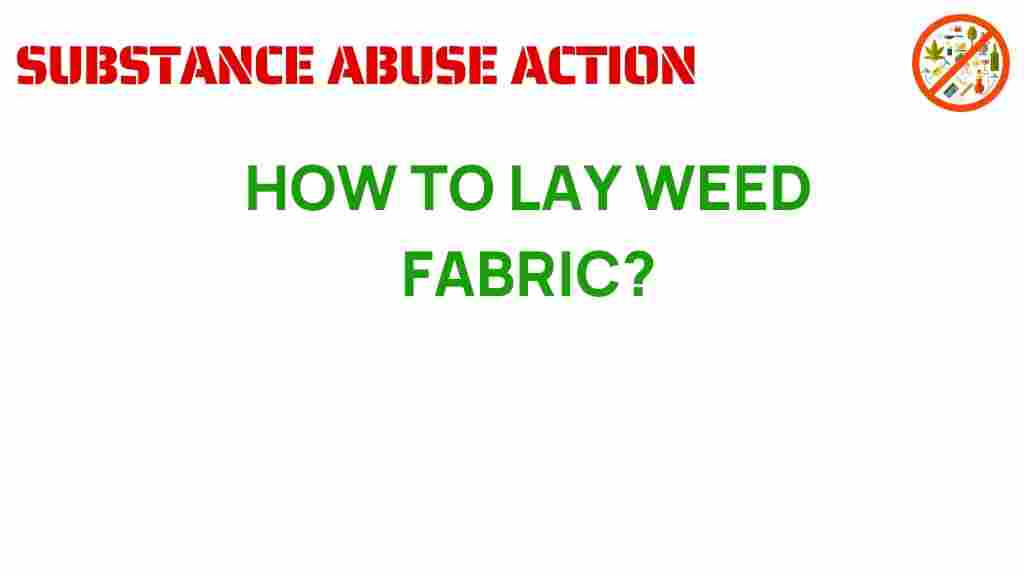Mastering Weed Fabric: The Essential Guide to Effective Gardening
Gardening can be both a rewarding and challenging endeavor. Among the many factors that contribute to a thriving garden, managing weeds is often at the forefront of gardeners’ concerns. This is where weed fabric, also known as landscape fabric, comes into play. In this comprehensive guide, we’ll explore the benefits of using weed fabric, effective gardening techniques, and tips for maintaining soil health while preventing weed growth.
Understanding Weed Fabric
Weed fabric is a permeable material designed to suppress weed growth while allowing air, water, and nutrients to reach the soil. Made from synthetic or natural fibers, it serves as a barrier between your plants and the invasive weeds that compete for resources. Here are some key benefits of using weed fabric in your garden:
- Weed Prevention: The primary purpose of weed fabric is to prevent weeds from taking root.
- Soil Health: By allowing moisture and nutrients to penetrate, weed fabric supports the overall health of your soil.
- Reduced Maintenance: Using weed fabric can significantly lower the amount of time you spend weeding your garden.
- Improved Aesthetic: Weed fabric can be covered with mulch or decorative stones, enhancing the visual appeal of your landscape.
Choosing the Right Weed Fabric
Before you start your gardening project, it’s essential to select the right type of weed fabric. Here are some factors to consider:
- Material: Weed fabrics are typically made from woven polypropylene, non-woven materials, or natural fibers like jute. Each type has its advantages.
- Thickness: Thicker fabrics offer better durability but may be more expensive. Consider the longevity you need based on your gardening style.
- Permeability: Choose fabric that allows water and nutrients to pass through while blocking sunlight to prevent weed germination.
Step-by-Step Guide to Using Weed Fabric in Your Garden
Now that you understand the importance of weed fabric, let’s dive into the step-by-step process of implementing it in your garden:
Step 1: Prepare the Soil
Before laying down the weed fabric, it’s crucial to prepare your soil:
- Clear the Area: Remove existing weeds, rocks, and debris from the planting area.
- Till the Soil: Loosen the soil with a garden fork or tiller to promote aeration.
- Test Soil Health: Conduct a soil test to check pH and nutrient levels. Amend the soil as necessary.
Step 2: Lay the Weed Fabric
Once your soil is prepared, you can begin laying down the weed fabric:
- Measure and Cut: Measure the area where you will place the fabric and cut it to size, allowing extra material around the edges.
- Position the Fabric: Lay the fabric over the planting area, ensuring it’s flat and free of wrinkles.
- Secure the Fabric: Use landscape staples or pins to secure the fabric in place, especially on windy days.
Step 3: Create Planting Holes
After securing the fabric, it’s time to plant your flowers, vegetables, or shrubs:
- Cut Openings: Use scissors or a utility knife to cut slits or X-shaped openings in the fabric where you want to plant.
- Dig Holes: Dig holes in the soil below the fabric, ensuring they are wide enough for the root systems of your plants.
- Plant: Place your plants in the holes and cover the roots with soil, pressing down gently.
Step 4: Add Mulch
To further enhance weed prevention and soil health, apply a layer of mulch:
- Choose the Right Mulch: Organic mulches like wood chips, straw, or shredded bark work well.
- Apply Evenly: Spread a 2-3 inch layer of mulch over the fabric, covering the entire area.
- Keep Clear: Ensure that mulch does not touch the stems of your plants to prevent rot.
Maintenance Tips for Effective Gardening
Using weed fabric is just one part of maintaining a healthy garden. Here are additional garden tips to keep your plants thriving:
- Regular Monitoring: Check for any weeds that may penetrate the fabric and remove them promptly.
- Watering: Ensure your plants receive adequate water, especially during dry spells. Drip irrigation systems can be beneficial.
- Fertilizing: Test soil regularly and apply organic fertilizers to maintain nutrient levels.
- Rotate Crops: Practice crop rotation to prevent soil depletion and pest build-up.
Troubleshooting Common Issues
Even with careful preparation, you may encounter challenges while using weed fabric. Here are some common problems and solutions:
- Weeds Persisting: If weeds appear, check for gaps in the fabric and ensure it’s securely fastened.
- Soil Compaction: If the soil becomes compacted, consider aerating it to improve drainage and root health.
- Pests: Monitor for pests and diseases. Use eco-friendly pest control methods to protect your plants.
Eco-Friendly Gardening Practices
Integrating eco-friendly practices into your gardening routine can enhance soil health and promote sustainability:
- Composting: Create a compost pile with kitchen scraps and yard waste to enrich your soil naturally.
- Native Plants: Choose native plants that require less water and are more resilient to local pests.
- Organic Methods: Use organic fertilizers and pest control methods to minimize your environmental impact.
Conclusion
Mastering weed fabric is an essential skill for any gardener looking to create a thriving, low-maintenance garden. By effectively using weed fabric, you can significantly reduce weed growth, improving both soil health and plant vitality. Remember to choose the right fabric, prepare your soil, and maintain your garden with eco-friendly practices for the best results. With these tips and techniques, you can enjoy a beautiful and productive garden year after year.
For more gardening resources and tips, check out this gardening guide. To learn more about plant care and sustainable practices, visit EcoGardening Journal.
This article is in the category Prevention and created by SubstanceAbuseAction Team
